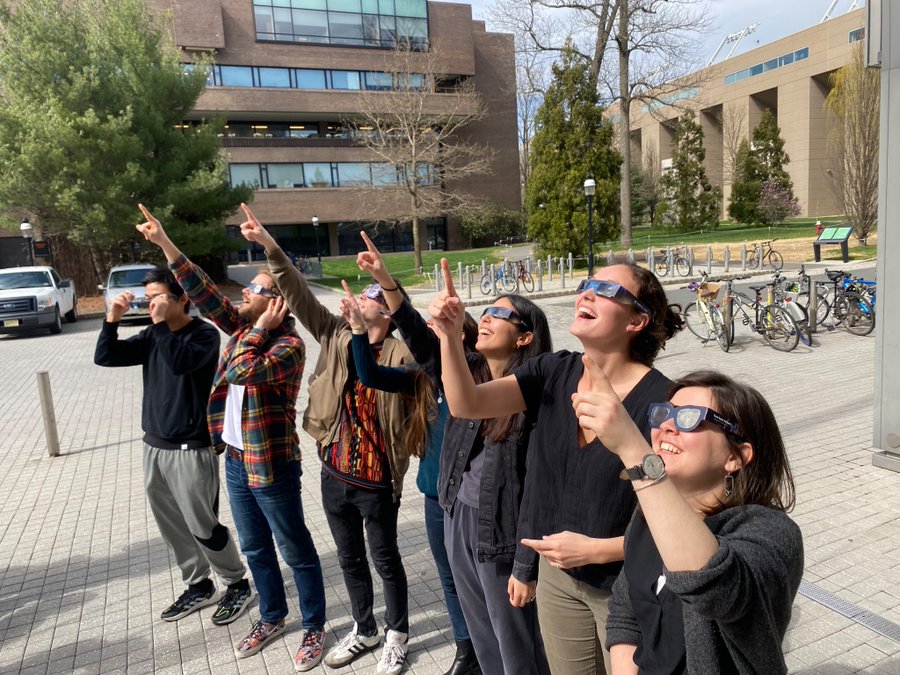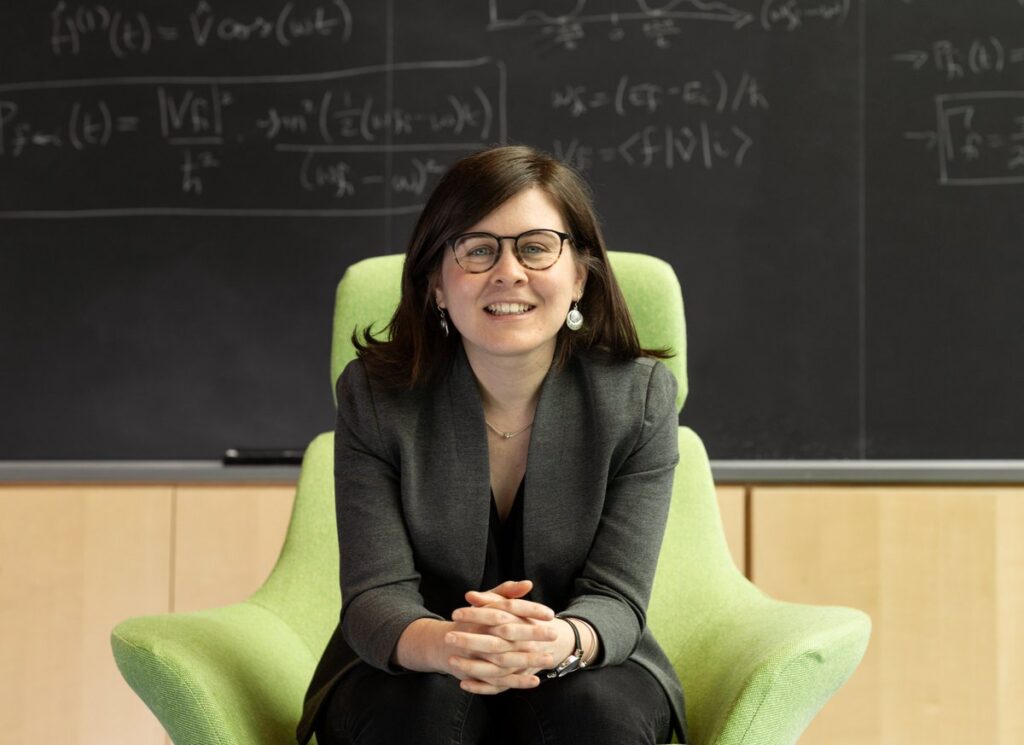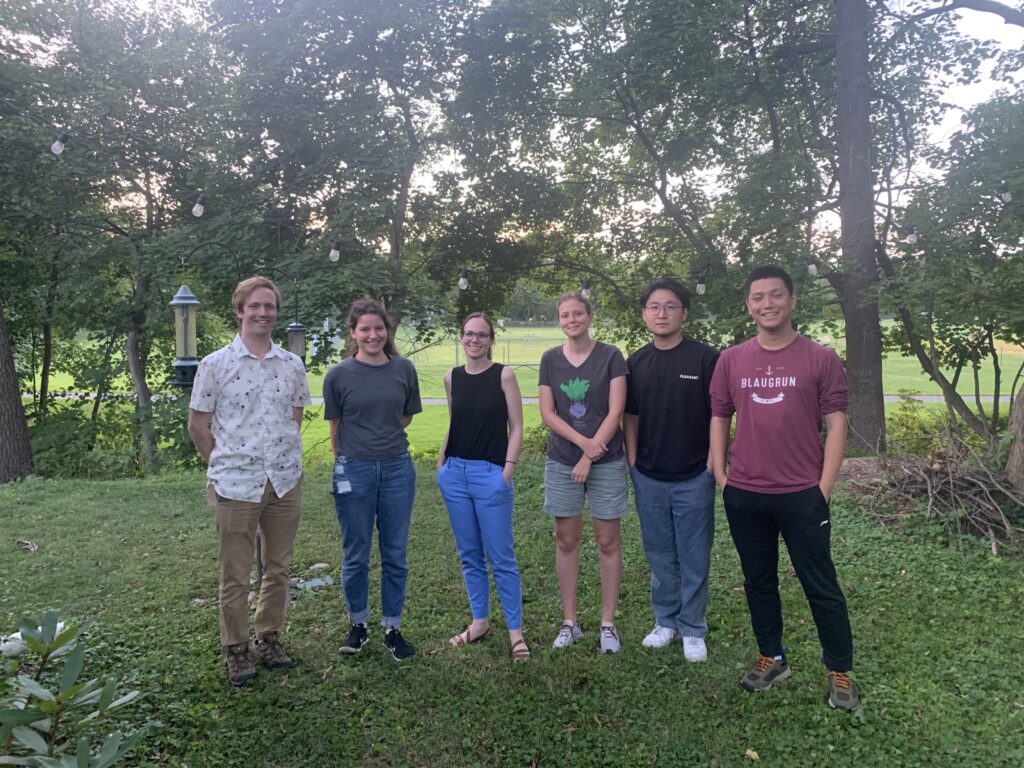Building a Lab out of Thin Air: Weichman, Roque, and Kunin

One of the marks of a great professor is the ability to spin gold out of thin air, driving new research, societal advancements, and in the case of three of Princeton Chemistry’s new professors, entire labs from the ground up.
Most assistant professors come to their first independent post with no formal training in this. They acquire skills in funding, recruitment, onboarding, instrument procurement, and framing a group mission even as they are running the new research that keeps them in business. Curious about this mythical process and what it was like for them, we asked three junior professors how they did it.
Spectroscopist Marissa Weichman was hired in 2020 and put together her first lab during the pandemic. Jose Roque, who works in the Catalysis/Synthesis subfield, said a strong network of senior colleagues at Princeton Chemistry was his go-to resource. Physical chemist Alice Kunin reflected on the issue of lab-building often when she was a grad student and postdoc as preparation for her own future.
Here are some of their key takeaways.
Assistant Professor Marissa Weichman
The Weichman Lab uses fundamental chemical physics and spectroscopy to probe the behavior of complex chemical systems and develop new ways to steer molecular processes using light. Weichman joined Princeton Chemistry in July of 2020. Today, her lab has six graduate students and three postdocs.
On starting out: “I love the whole academic enterprise: basic research, education, training students. But when you’re an undergrad or a grad student you see just the tip of the iceberg of what the job of a P.I. is — you can’t really see what it takes to start new research projects and onboard people and manage instruments ahead of time. It’s a big challenge to start as an assistant professor and have to level up all at once. It’s a matter of paying your dues for the first few years to do the hard work of setting everything up and then you can start to reap the rewards of having a great group.”

Assistant Professor of Chemistry Marissa Weichman.
First steps: “In some ways the transition to becoming a P.I. was easier for me because of the pandemic. I didn’t have lab space or group members for most of the first year so the only thing I could do was think deeply about what we should be working on. I wrote a lot of proposals that year so that I could say to new group members, here’s a roadmap of what we’re going to do. I thought a lot about what problems to go after. And some of those proposals got funded early on, which was a really nice validation of the science. Someone once told me that a research group has to act a little bit like an engine, with three pieces to it: there are the people, there’s the research output, and there’s the funding. You need people to get results, you need results to secure grant funding, and you need funding to pay people. It’s a big lift to get this cycle started. You have to prime it with getting the right people on board and then pointing them in the right direction. Hopefully once you get the flywheel moving, it spins up and keeps moving under its own momentum.”
Refining research goals: “The job market and interview cycle was really fruitful for me because of the kinds of questions you’re forced to think about: which project is most likely to work, which is your favorite project, what is the thing you’re going to set up first? You’re sitting up there in front of the whole department and get to hear all their ideas and reactions. There were some really good questions, so I got to hone my proposal ideas through that process. I started with a combination of parallel projects where some were short-term and we could get something out of them quickly, and then some things that I knew would be a slow burn. You have to have both short- and long-term thinking.”
Good lab vibes: “When people join my group. I say, I am here to support you and teach you things and challenge you and I will give you the benefit of my advice and experience. In exchange, I want you to work hard and be self-motivated and we get to create this great thing together. I wrote a group handbook that puts down everything that I envision for my group. I wrote it in part for myself, and then I have students read it when they join the group. We try to really live by it. In a young group, you need everyone to be engaged and participating and every project to work. So your interests are really aligned with your students.”
Assistant Professor Jose Roque
The Roque Lab works at the interface of organic and organometallic chemistry with an emphasis on the development of new reactivity modes to address unsolved problems in catalysis. Roque started in July of 2023. Today, the lab has seven grad students and five postdocs.
Postdoc impressions: “The labs I had been working at were some of the top in the country, very well-established. Everything was just flowing smoothly: the equipment was there, the infrastructure, the senior grad students, the postdocs. And so as a student you just focused on the science. You didn’t need to reflect on the stuff I’m learning now: finances, how to manage a group, scheduling, training, how to recruit. What you want is to get to that point again, where everyone’s focused on the science and it all runs effortlessly.”

A game of Jenga at one of the Roque Lab get-togethers, with Assistant Professor Jose Roque (left) and graduate student Aleksandr Knyazev.
Two great moments: “There were two moments when I really knew I was a P.I. First, when they give you the keys and you open up your lab and it’s an empty canvas. I was extremely excited. And second, when you start recruiting students; because you know they bought into the mission and they want to do the science. That was really special for me when we had our first subgroups and you have students who are dedicating their Ph.D. to a particular project because it’s something you and they deem important. It’s a remarkable journey you embark on as a team with full creative freedom. All the sudden, holy cow, there’s no one else vetting this. It’s a huge privilege and I take that really seriously.”
Recruiting ‘bold’ students: “At Princeton, the science has to come first. These students just want to do next-level stuff. They want to do innovative science. And then, I think, it’s building the vision and really showcasing that what they’re doing is at the limits of the ‘known.’ The goal is to enter uncharted territory and continue to push the boundaries. The idea that no other lab is working on this and you’re starting from the ground up – this resonates with a certain select group of students who are bold enough to work with an assistant professor.”
Paying it forward: “Senior colleagues provide a good framework for saying to junior professors: ‘Okay, at one month in maybe get the science off the ground because if you don’t have papers you’re less competitive for grants.’ And then from there, they’ll say, based on your discipline you should be thinking about applying for this and for that and maybe hold off on applying for that other funding for now. You’re focused on doing great science but you also don’t want to miss something or slip up on the finances or the recruiting and navigating all these complexities. So it’s the infrastructure of senior colleagues that really makes this thing work.”
How to lead: “It’s constant reflection about what I should be doing and thinking of ways I can improve. I ask myself, if I was a student, would I be proud to have me as an adviser? Am I leading as opposed to bossing around? Am I contributing from the big picture all the way to the technical details? I guess what I look at now is how frequently I’m impressed (very frequently!) by my students and seeing them outgrow my expectations. That’s how I know I’m doing my job. My second-year students, they just wipe the floor with how I was when I was a second-year.”
Assistant Professor Alice Kunin
The Kunin Lab uses ultrafast spectroscopy to resolve fundamental light-induced processes in condensed phase systems. Kunin started at Princeton Chemistry in January of 2024. After just one year, her lab has four graduate students and two postdocs.
Working in labs large and small: “I did that a little strategically because I knew a lot of people in my cohort who did their Ph.Ds. and postdocs in big schools and at big labs. I was interested to see ahead of time a little window into what both looked like. I purposefully chose a different vibe and a different environment for doing postdoc research than my Ph.D. because I wanted to see other departments and see what it would look like to manage a smaller team with more P.I. involvement. So now, I’m ending up somewhere in between, and that was the benefit of seeing different types of research environments.”

The Kunin Lab (Assistant Professor Alice Kunin third from left) at a lab event last summer.
More mentorship needed: “The things you don’t get from a mentorship perspective are, particularly, financial management – how much money do you really need to keep a lab alive, when should you pursue it, who should you pursue it from, which funding agencies and different programs within that agency should you approach? Basically, how to navigate the whole funding scheme. And the other thing is managing people. In the last 11 months, I have gained six employees. In the past maybe I would mentor one or two grad students but they were still running their own projects. And now they’re all looking at me and saying, where to boss? You have to keep all the plates spinning at the same time.”
How to recruit: “I remember when I was a grad student, I wanted to join a big group where I could contribute but I wouldn’t be singled out with my P.I. But my first grad student wanted the opposite of that. She wanted to lead and build everything with her own two hands. I think it really takes a student who is fearless to join a new P.I.’s lab and say, I’m going to trust in this person. When you’re hiring postdocs, you have to think about how is this person going to be as a mentor for my students, do they have good research skills, can they get a project over the finish line, are they going to be a right fit? Not everybody is the right personality to build a lab from an empty room.”
One thing: “One thing I definitely wish I had done was push more to do a quick hire for a postdoc – have a postdoc who shows up with me on Day One. It was a huge help when my first postdoc started in July because he could take on a leadership role. It needs to be the right personality, of course, because you’re two people taking on a leadership role at the same time. But finding that right person who can start with you on the very first day really gives you a leg up.”
What success will look like: “That’s part of why I’m not recruiting as heavily right now because I’m really happy with the crew I have. They’re a mix of different scientists and different personalities and I think they gel really well. So I feel good about that. I’m very much looking forward to our lab reno wrapping up in the spring and I think I will breathe that sigh of peace when we move into our new room. It’s a once-in-a-lifetime experience, isn’t it? You might start a new project or one day move the lab, but you’re never again going to build a lab from scratch for the first time. It’s been a bit of a crazy ride but I’m really enjoying it.”
